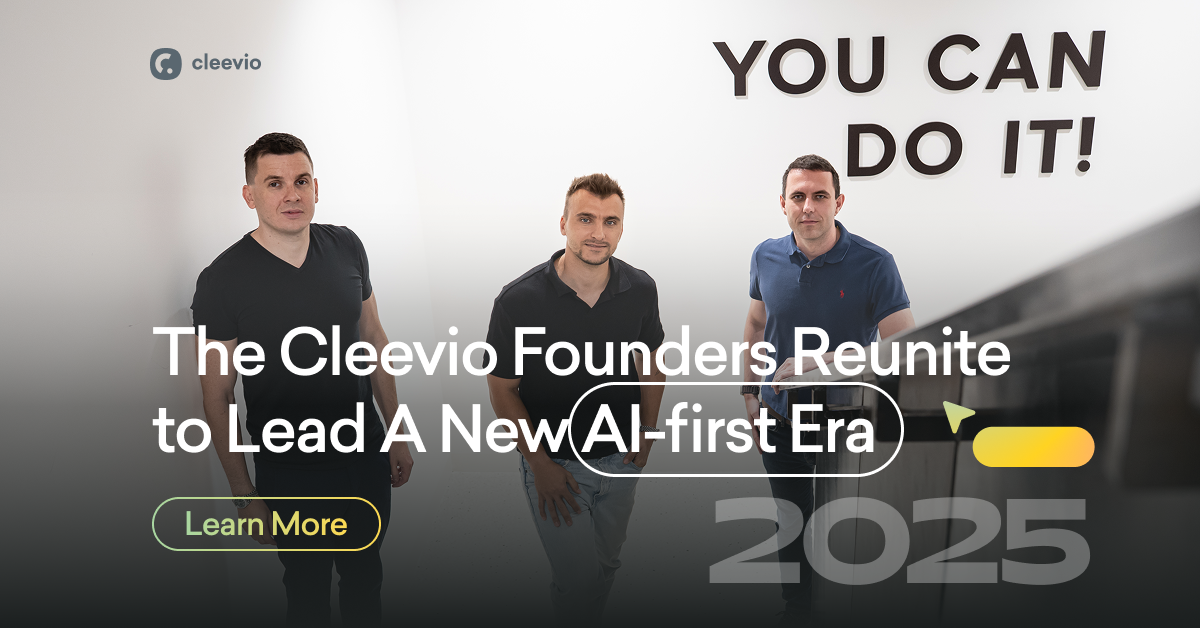Dive into the latest industry wisdom from

our experts

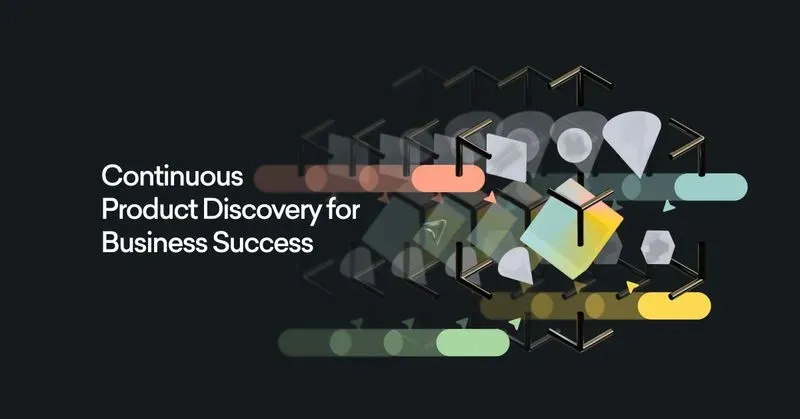
Continuous Product Discovery for Business Success
Understanding your users' needs and crafting a product that truly adds value is crucial for success. A well-structured product discovery process is the key to a successful MVP launch. But to sustain that success, you must embrace continuous product discovery – an ongoing commitment to innovation and improvement. Continuous discovery involves product teams constantly seeking new insights into user needs through research activities like regular customer interactions and hypothesis testing. This process doesn't stop when product delivery begins; teams maintain curiosity and adapt based on their discoveries.
Origins of Continuous Product Discovery
Continuous Product Discovery gained prominence through the work of author Teresa Torres. Torres emphasizes the importance of gathering insights from customers every week, which can be accomplished through various means such as prototype tests, interviews, surveys, and more. Achieving success in product development hinges on the art of co-creation with customers. Considering that a product is a perpetual work in progress, these ongoing customer dialogues must persist consistently.
Benefits of Continuous Product Discovery
Continuous product discovery delivers a display of benefits for product teams. To start, it provides a structured approach for generating, visualizing, and implementing ideas, effectively reducing conflicts, biases, uncertainties, and risks. Additionally, it elevates the quality and viability of decision-making while optimizing resource allocation.
Moreover, it guarantees that your products remain aligned with the ever-evolving needs of your customers, enabling swift adaptation to changing insights. This methodology also nurtures innovation by stimulating the development of pioneering product concepts and the validation or dismissal of assumptions.
By integrating customer feedback into the design process, continuous product discovery fosters customer-centric thinking and enhances team expertise. It also addresses the information bias by maintaining an ongoing feedback loop, facilitating customer product adoption, reducing time to value, and minimizing churn. Ultimately, it heightens the overall user experience by ensuring accessibility, credibility, desirability, usability, usefulness, and value for both customers and the business.
The First Step
The initial step toward adopting continuous product discovery involves establishing a dedicated discovery team responsible for orchestrating your ongoing discovery process. Typically, this core team comprises a product manager, a designer, and a lead engineer. It's important to note that you don't have to undertake this journey alone. Collaborating with specialized product discovery companies, such as Cleevio, can also streamline and enhance your continuous discovery efforts, offering valuable expertise and support along the way.
The 6 Essential Principles
Ready to start your continuous product discovery journey? We've got some valuable tips for you:
- Focus on Outcomes: Shift your focus from just building to understanding the impact of your solutions on customers and the value they bring to your business.
- Learning Through Discovery: View research as a means to challenge assumptions about user needs and how to address their pain points, rather than as a way to confirm existing ideas.
- Embrace Continuity: Don't get trapped in an endless loop of feedback validation. Not every decision requires exhaustive discovery; sometimes, building can provide quicker insights into proposed solutions.
- Progress Over Perfection: Release the notion of perfection in every deliverable; it's an elusive goal. Embrace a continuous mindset that values incremental enhancements and ongoing value addition.
- Empathy Matters: While automating scheduling can save time, ensure that your interactions during testing sessions and interviews are never mechanical. Infuse empathy into every discovery conversation, guided by your genuine concern for user needs.
- Discovery as a Constant: Don't relegate discovery to a one-off event at the project's outset. Instead, make it a consistent source of feedback and assumption testing throughout your product development journey.
Absorbing a wealth of new information can be overwhelming. Yet, you don't have to tackle it all on your own. When it comes to selecting a partner for your product discovery voyage, choose wisely.
At Cleevio, our commitment is to assist you in crafting exceptional products that resonate with customers, ultimately driving satisfaction and success for your business.

European Crypto Asset Regulation 101: The Business Impact of TRF
With the cryptocurrency market expanding, governments and financial authorities worldwide are stepping up their efforts to regulate this dynamic and innovative domain. In Europe, the rise of crypto assets has prompted the establishment of a comprehensive regulatory framework, and a vital component of this framework is the Transfer of Funds Regulation (TRF).
Basics of the Transfer of Funds Regulation
For businesses operating in the crypto space, understanding and complying with TRF have become essential aspects of their operations. Today, we delve into the intricacies of TRF regulation and its implications for enterprises involved in crypto assets. By learning the significance of TRF and its impact on financial activities, businesses can navigate the evolving regulatory landscape and adapt their strategies to align with the new era of financial oversight.
TRF is a European regulation aimed at preventing illegal activities like money laundering and terrorist financing. It proposes applying equivalent rules to cryptocurrency transactions as ordinary money transfers. This will significantly impact both service providers and users.
Compliance Requirements for Crypto Businesses
If you are engaged in providing crypto services or have plans to start, it's important to be aware of the TFR's requirements. This regulation mandates maintaining and verifying information about the origin and recipient of cryptocurrencies. Such data must be shared with relevant regulatory authorities. Additionally, before disclosing crypto assets, it is crucial to ensure that the source is not listed in the register of risk-takers maintained by the European Banking Authority (EBA).
Keep in mind that these obligations apply to every transaction, regardless of its value, except for direct transfers between users. European legislators have intentionally avoided setting specific thresholds due to the inherent volatility of cryptocurrency prices and the potential for creative attempts to circumvent the rules. Complying with these regulations is essential for smooth operations and compliance in the crypto services sector.
Implications for Hardware Wallet Users
The impact of the TFR on hardware wallets, such as Trezor or Ledger, is noteworthy. The technical and financial complexities involved in meeting the proposed requirements could pose potential complications for users of wallets not directly hosted by crypto asset service providers.
Complying with the obligations outlined in the TFR becomes notably more challenging for holders of hardware wallets. As a result, there is a genuine risk that service providers may opt to discontinue support for users of hardware wallets. By doing so, they can avoid the potential sanctions associated with non-compliance under the legislative framework. This situation adds an interesting dimension to the evolving landscape of cryptocurrency regulations and its implications for hardware wallet users.
Navigating the Changing Regulatory Environment
For those involved in the crypto business, staying vigilant about the latest developments in the mentioned legislation is of utmost importance. Additionally, it's essential to keep an eye on any new regulations that may surface in the coming years, like the Data Act, which could require the implementation of a Kill Switch for smart contracts.
As a user and crypto enthusiast or investor, you can expect increased transparency and legal security when investing in new projects in the future, thanks to these regulations. However, the risk of crypto asset volatility and potential fund losses cannot be entirely eliminated by these or any other legislation. Being well-informed and cautious remains crucial in the dynamic world of cryptocurrencies.
This article was created in cooperation with HAVEL & PARTNERS.
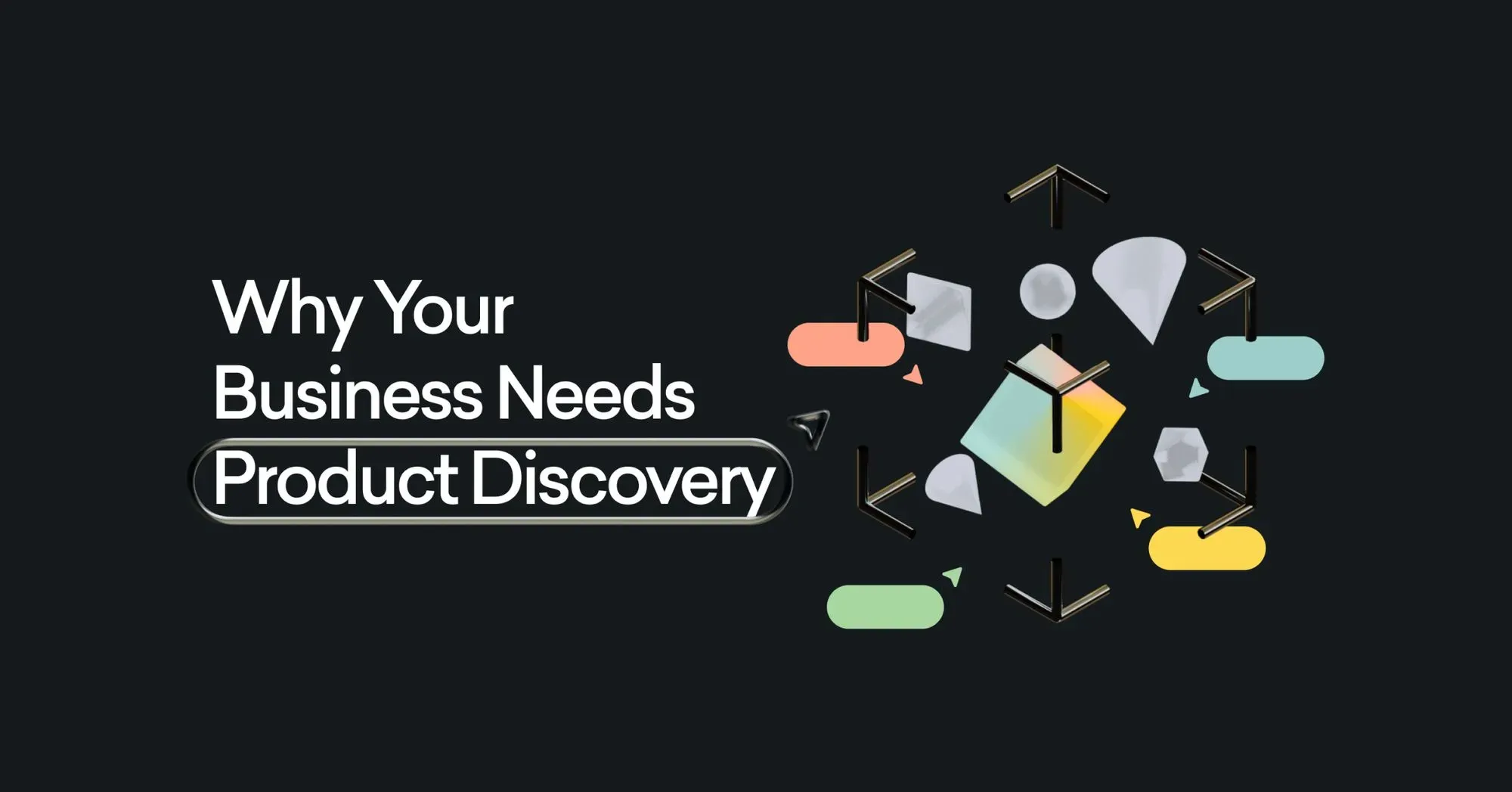
Why Your Business Needs Product Discovery
Introducing a new product to the market is no easy feat. The journey from ideation to a successful launch demands thorough planning, strategic thinking, and a deep understanding of your target audience. It's a complex endeavor that can challenge even the most seasoned entrepreneurs.
Fortunately, there is a helping hand: the process of product discovery. This phase holds the key to uncovering the secrets to product success and mitigating the risks that often accompany new ventures. Are you ready to unlock the benefits of product discovery? Let's dive in and discover why embracing this process is essential for your business. But first, secure your free e-book and explore every step of the process.
The importance of product discovery
Product discovery is a process helping businesses to identify, understand, and validate opportunities for new products or enhancements to existing ones. Discovery involves a comprehensive exploration of customer needs, market trends, and technological possibilities to uncover insights and drive innovation. Through research, user interviews, prototype testing, and continuous feedback loops, product discovery helps teams gain a deep understanding of user pain points and preferences. It allows businesses to align their product vision with market demand, reduce risks, and increase the chances of delivering successful products. Ultimately, product discovery empowers organizations to make informed decisions, prioritize features, and create valuable solutions that resonate with their target audience.

Product discovery should be a continuous practice, not a one-time task. At Cleevio, we believe in integrating discovery and delivery to reduce risks and build the right products faster. Whether you're new to product discovery or already implementing it, there's always room for improvement. That's why we've written an ebook that delves into the strategies and techniques for effective product discovery. Download our ebook to learn more about product discovery and unlock the secrets to building successful products in a shorter time. Start your journey to creating a great product today!

Your partner for better product discovery
Discover the ultimate guide to enhancing your product discovery with ‚Product Discovery 101‘. Inside, you’ll find a step-by-step approach, valuable insights on avoiding common mistakes, and how Cleevio can elevate your product discovery process. Download now and unlock the secrets to successful product discovery!
What will you learn?
- Strategies to maximize your ROI
- Three essential steps to achieve success
- Techniques for researching, defining, and prototyping the perfect product
- And much more!
Want to know more? Read our ebook, "The Digital Entrepreneur’s Holy Grail: Essential Topics for Startup Victory" or reach out to our team for more information.
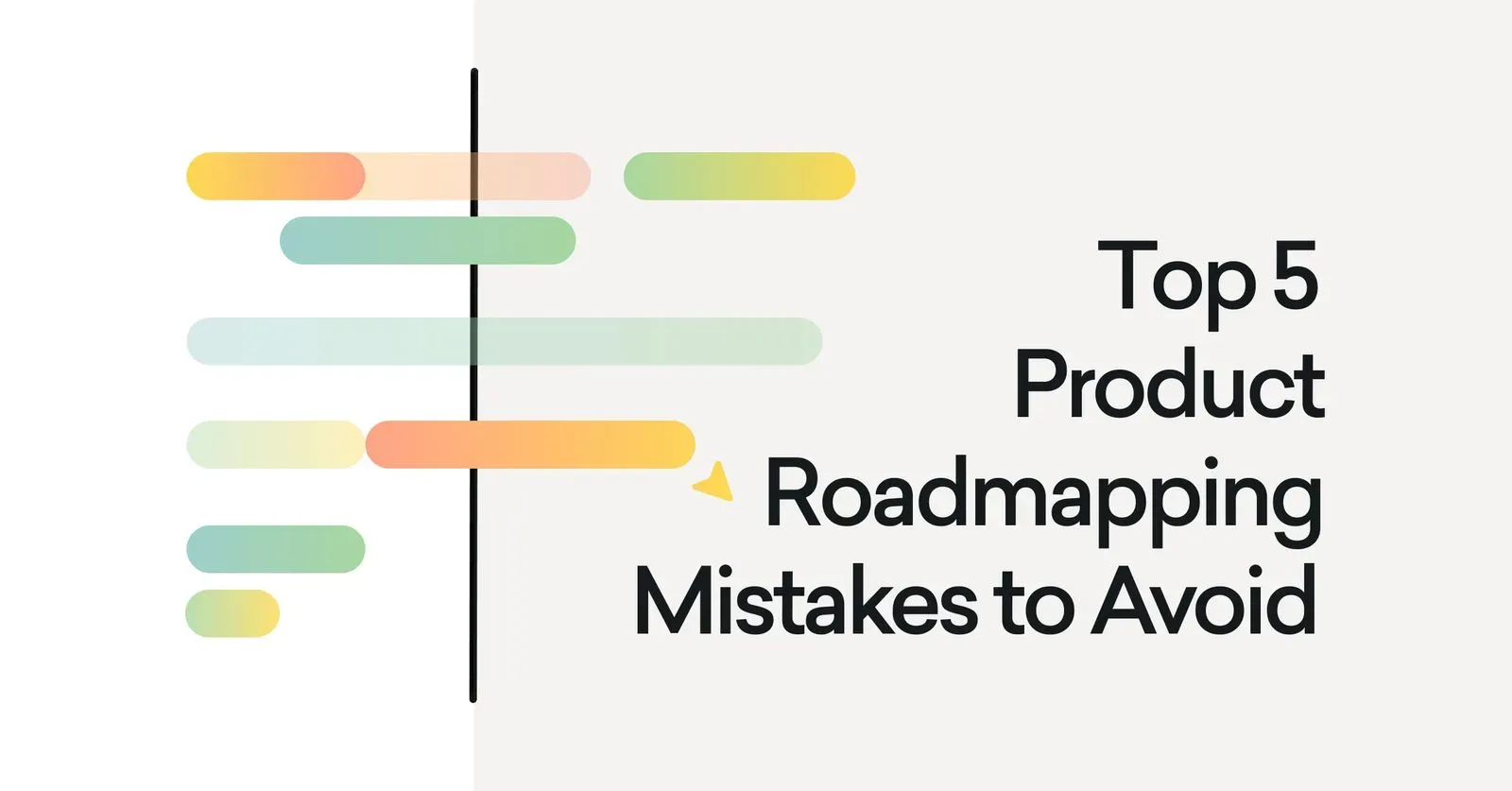
5 Product Roadmapping Mistakes to Avoid
A goal is crucial for success; without it, you will always miss the mark. Equally important is the roadmap to achieve that success. A product roadmap serves as a strategic document that goes beyond mere feature listing. It articulates the product's direction and vision over time, providing a clear path to follow. The roadmap acts as a guide, facilitating the execution of the product strategy while simultaneously serving multiple goals. By bringing stakeholders together, fostering a shared understanding of the product's strategy and vision, and maintaining focus on priorities, the roadmap becomes a trusted and reliable source of truth for all involved.
When developing a product roadmap, it is important to be mindful of potential pitfalls. Unfortunately, certain mistakes in product roadmaps can have adverse effects, ultimately leading to product failure. What are some of these mistakes that you should avoid?
Mistake # 1: The danger of excessive detail
It is a common occurrence where managers tend to make the mistake of becoming overly specific and including extreme details in the product roadmap. This includes information regarding planned feature development, estimated timelines, and resource allocation. While these details hold significance, it is essential not to overload the product roadmap with them, as it can overwhelm your team.
To achieve maximum effectiveness, prioritize simplicity. Product roadmaps serve as powerful tools for guiding and visualizing progress. However, their power diminishes when burdened with excessive details at every process stage. For a cohesive strategic vision, maintain a simple and focused product roadmap. Emphasize clarity and conciseness to ensure its result.
In my experience, I've seen many managers make this mistake of overwhelming the product roadmap with excessive details. It's easy to get caught up in the nitty-gritty of feature development, timelines, and resources, but to truly guide and empower your team, simplicity is key. A focused and clear product roadmap is what drives real progress and success.
Michal Počuch, Head of PMO @Cleevio
H2: Mistake # 2: Surrendering to stakeholder demands
While it is rational to value and listen to stakeholders, it is necessary to remember that your primary goal is to achieve product success rather than trying to please other people. Saying yes to every stakeholder request can lead to the unwanted product. Strive to strike a balance between stakeholder input and your product vision to ensure the development of a desirable and successful output.
However, it is important to avoid excluding stakeholders and development experts from the process. When individuals do not have the opportunity to contribute, they are less likely to support the roadmap. Therefore, it is crucial to involve relevant stakeholders and experts to foster ownership and gain broader support. Collaboration and inclusion are key to creating a successful and well-supported product roadmap.
.avif)
Mistake # 3: Setting a Fixed Roadmap
Too often, companies invest time and effort in crafting their roadmaps, only to abandon them after a few months. This neglect to make necessary adjustments can lead to problems as the product evolves during design and development. A product roadmap serves as a strategic forecast.
To keep it applicable, update it at least once a quarter. This proactive approach will maximize the chances of creating a product roadmap that aligns with your current objectives and effectively visualizes upcoming events or changes.
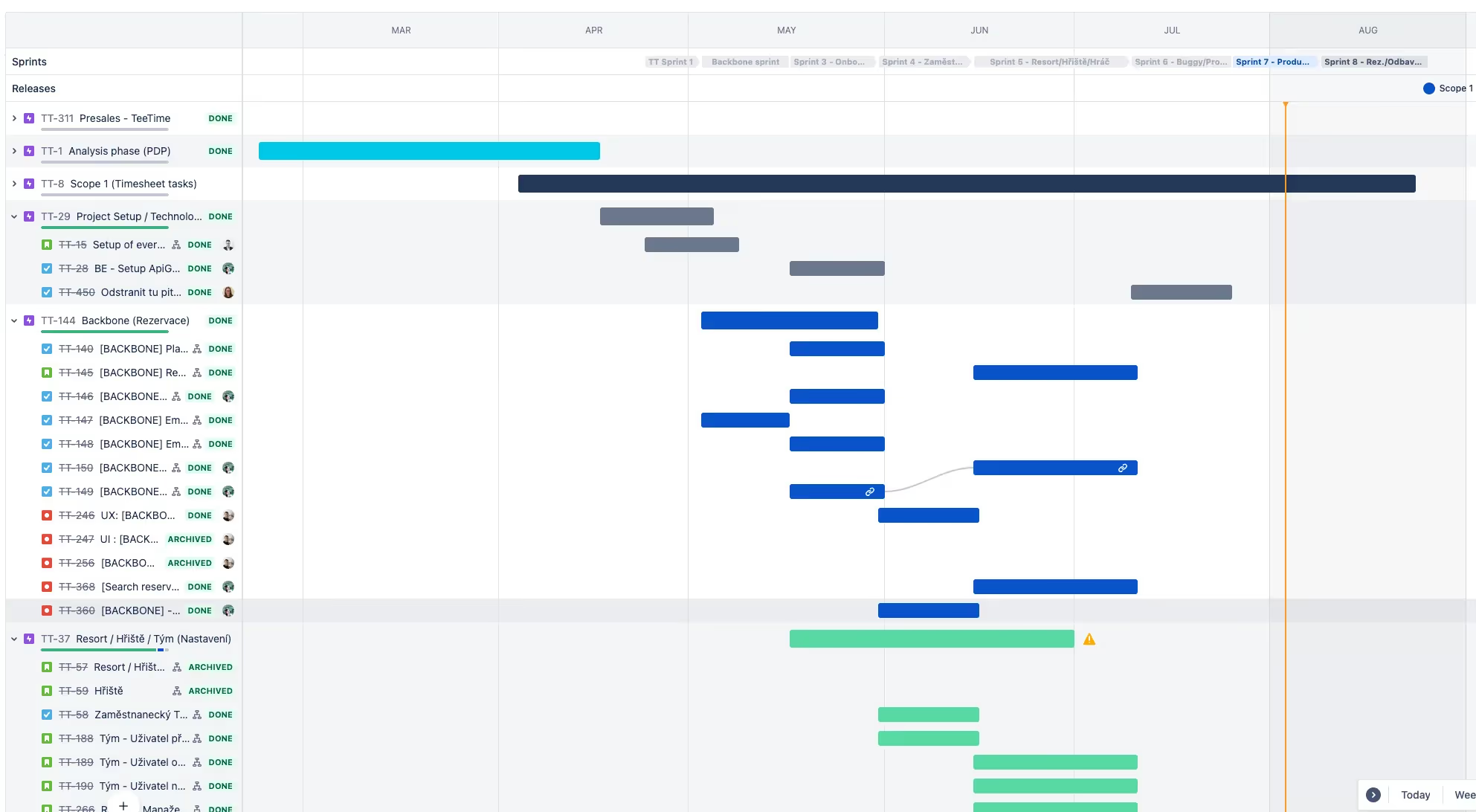
Mistake # 4: Avoiding the backlog
The product backlog is a great tool that consists of task-level jobs, such as stories and defects. It serves as an internal document primarily for the product and development teams. By simply looking at the backlog, you can see what tasks are next on your development team's to-do list as they work towards executing the big-picture vision outlined in your roadmap.
A disconnected roadmap and backlog can result in inconsistent and wrong product decisions. It is critical to maintain synchronization and regular updates between both. Avoid allowing them to become standalone documents that convey conflicting messages. This requires regularly referencing the roadmap to verify alignment between the prioritized backlog items and the strategic objectives outlined. Additionally, proactively ensure that the backlog remains organized and streamlined at all times.
Cleevio Tip: Keep your product roadmap and backlog in sync by regularly cross-referencing them.
Mistake # 5: Overplanning and over-committing
When confronted with external pressures from competitors, investors, and customers, it can be tempting to become a "yes man" and overload your roadmap with a number of tasks. Yet, this can be a detrimental mistake. Overcommitting to unrealistic expectations and adding too many objectives to your roadmap can lead to inferior results and project delays.
To avoid this mistake, carefully evaluate the feasibility and capacity of your team before adding tasks to the roadmap. Prioritize quality over quantity and ensure the problem aligns with your resources and capabilities. By setting realistic expectations and avoiding overcommitment, you can maintain focus, deliver better outcomes, and avoid unnecessary stress and setbacks.
The takeaway
Creating a successful product roadmap demands careful thought and educated choices. Make your roadmap more effective by avoiding common mistakes and following best practices. To stay on the right track, we recommend utilizing our expertise and reaching out for a consultation.
Let's work together to optimize your roadmapping strategy and set the stage for a successful product journey.
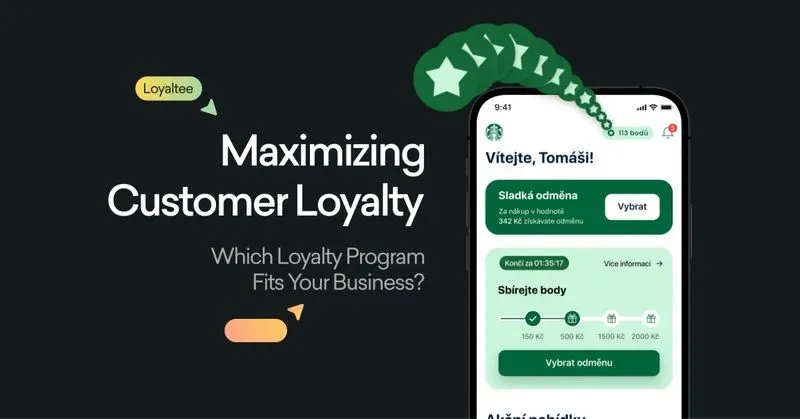
Maximizing Customer Loyalty: Which Loyalty Program Fits Your Business?
Retail business competition in the digital age goes far beyond product and price. The differentiating factor now pivots around the customer experience, where the focus is to acquire, engage and retain customers. Loyalty programs, a crucial component of customer retention strategies, offer tangible ways to deepen the bond between your brand and customers. Delve deeper with us into the different customer loyalty program types and their use for different types of businesses.
Points-Based Loyalty Programs
One of the most omnipresent loyalty models is the points-based system. This mechanism operates on a simple principle: customers accumulate points based on their purchase value, redeemable for future rewards.
Retailers with a high frequency of repeat purchases and a diverse product range often find points-based loyalty programs highly effective. They're particularly suited to physical retail stores, supermarkets, and coffee shops, where the simplicity and immediacy of earning points are highly engaging.
This program is also highly compatible with an omnichannel approach. Customers can accrue and redeem points in-store and online - creating a seamless customer experience.

Tiered Loyalty Programs
Tiered loyalty programs introduce stratification to the rewards structure. These systems provide immediate value upon entry while progressively enhancing benefits as customers climb the loyalty ladder.
Ideal for businesses offering premium products or services, tiered loyalty programs work well for high-end retail and e-commerce platforms. These businesses typically have longer purchase cycles and high customer lifetime value, making the extended engagement strategy of tiered rewards highly beneficial. The personalized nature of the rewards also aligns well with omnichannel retail, providing consistent benefits across all customer touchpoints.

Subscription-Based Loyalty Programs
This model invites customers to pay an upfront fee, securing exclusive benefits and privileges. Despite the entry fee, these programs can prove enticing when the offered value outweighs the cost.
These programs are particularly suited for e-commerce businesses or retailers with significant online presence, such as Amazon with its Amazon Prime program. A subscription-based program promises exclusivity and additional benefits, including free shipping or early access to products, which are highly valuable for frequent online shoppers. With the appropriate integration, they can also work in an omnichannel setting, providing value wherever the customer interacts with the brand.
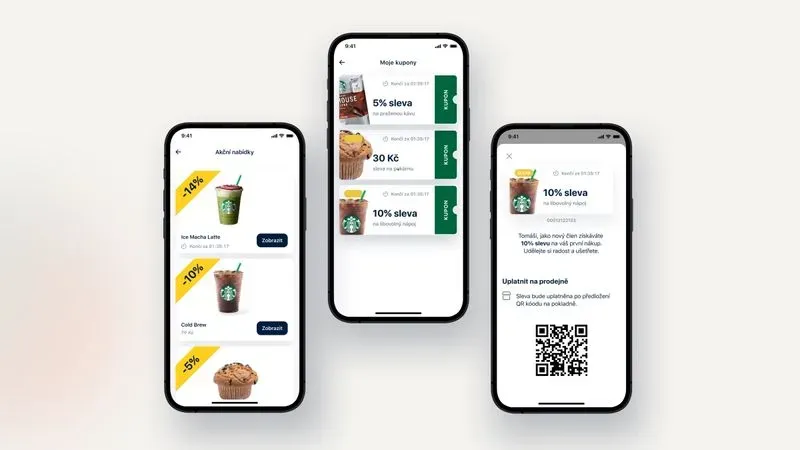
Coalition Loyalty Programs
Coalition or partnership programs allow businesses to join forces, providing customers with an expansive rewards ecosystem. Leveraging our comprehensive API integrations, retailers can connect their loyalty programs with potential partners, enabling customers to earn and redeem points across a spectrum of retail and e-commerce experiences.
A strategic fit for non-competing retail partners with similar target demographics, coalition programs are a win-win for all parties involved. They work smoothly in an omnichannel environment where the participating businesses complement each other's offerings. Coalition programs can significantly enhance the customer experience by providing a more extensive rewards landscape across different retail categories.
Charity-Based Loyalty Programs
Incorporating social responsibility into loyalty programs, charity-based models allow customers to donate a portion of their purchase to a chosen cause - resonating immensely with customers who prioritize philanthropy.
For brands with strong social responsibility values, charity-based loyalty programs are an excellent choice, whether in traditional retail, e-commerce or an omnichannel model. By allowing customers to contribute to a cause they care about, these programs create emotional bonds, fostering customer loyalty while making a positive social impact.
Support this noble initiative with Loyaltee, enabling you to automate the allocation and donation process while keeping customers informed about the impact of their contributions.
Customer loyalty programs are not merely points-and-rewards initiatives - they are strategic tools that elevate customer engagement, driving long-term business growth. By leveraging loyalty solutions, retailers can harness this potential, delivering exceptional customer experiences while building enduring customer relationships.
Cleevio's Loyaltyee's versatility allows retailers and e-commerce players to customize these loyalty program models or even blend them to create a unique system that aligns with their brand ethos and customer demographics. By leveraging robust data analytics, our solution provides valuable insights into customer behavior, enabling you to fine-tune your programs for the best business results.
Explore these loyalty programs and unlock the next level of your success.

17x Growth in 30 Days: Our Secret Sauce Exposed!
Maybe you’ve experienced something similar. You launch a new product with a great initial response, but as time goes on, interest fades and demand stagnates, or worse, declines. On the surface, everything seems fine - you have website visitors, an acceptable bounce rate, and leads coming in. However, the critical issue remains: conversions and revenue are lacking.
Perhaps you dismiss it with a thought, 'Well, that only happens to amateurs.' However, this scenario is not exclusive to inexperienced players. It occurred even for a well-financed start-up, backed by venture capital funds and headquartered in Silicon Valley.
With one of our projects, three years in the market, and a nearing 500k user base, it was steadily growing - until it wasn't. They decided to seek a partner who could assist them in addressing this situation. We collaborated with them to develop a comprehensive plan for sustainable revenue growth. To ensure the best possible outcome, we utilized the Product Discovery Process. The result? The impact was indeed remarkable. After implementing the insights gained from our Product Discovery Process, their revenue surged by an astounding 17 times in just one month.
Laying the Foundation with Product Analysis
Jointly with the client, we delved into an in-depth product analysis to identify the key issues we needed to address. We reconsidered the core problem and evaluated the product’s functionalities. Then, we closely examined the rationale behind certain features and their alignment with the business value. All this was done by analyzing a pile of contextual and non-contextual data generated through users’ interaction with the product in the previous period. Additionally, we used a product canvas that revealed significant areas of misalignment within the product.
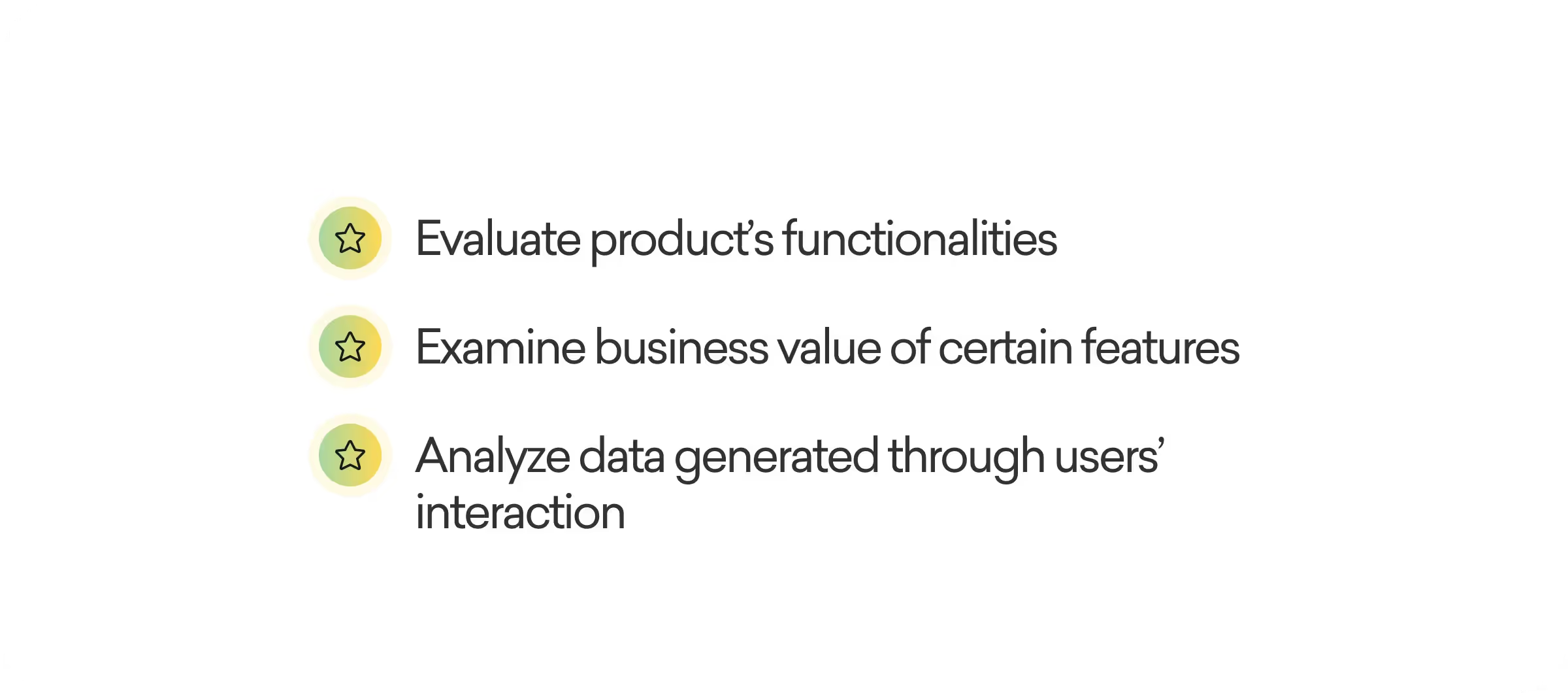
It became evident that 3 main areas demanded immediate attention:
Unfocused and Overwhelming Offer: Despite effectively addressing multiple user pain points, the innovative product suffered from excessive features, which dimmed its unique selling proposition and caused confusion among users.
Lengthy Conversion Funnel: The user journey from initial engagement to conversion proved excessively long, with too many options in each step of the funnel and a lack of clear and engaging information that would take the user to the final destination - conversion.
Non-transparent Offer and Pricing Model: The placement of the payment gateway disrupted the user flow toward conversion, while the subscription-based pricing model contradicted the product’s value proposition, requiring adjustments for better clarity and alignment.
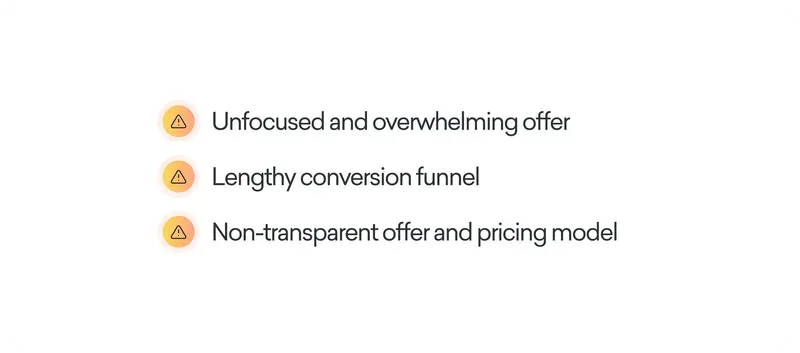
Time for Market and Competition Research
Next, we delved into comprehensive research on the market ecosystem and competition. Our primary objective was to understand how our client's product compared to others in the market. We identified direct and indirect competitors, while also studying the successes and, more importantly, the failures of similar products. This competitor's analysis enabled us to find market gaps and strategically position our client's product.
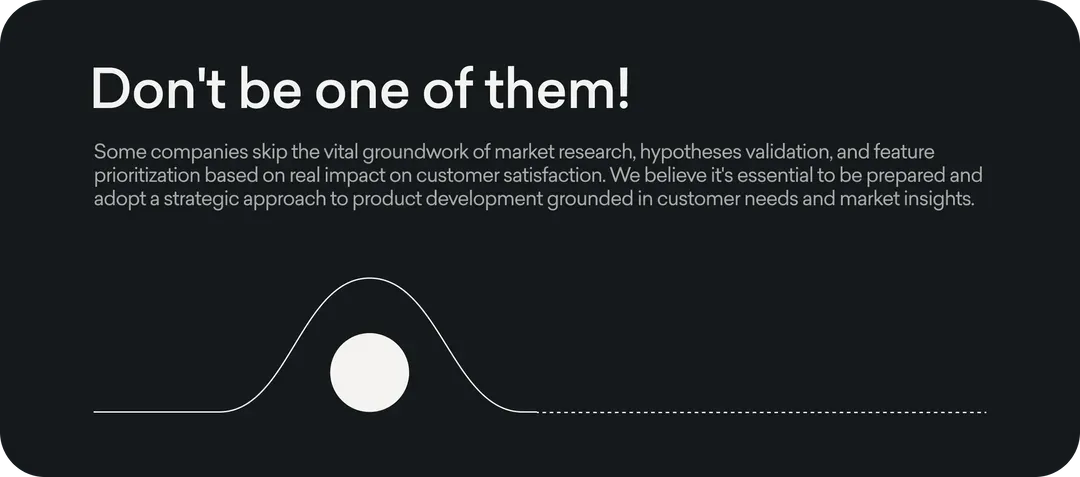
Developing Hypotheses, Mapping User Journeys, and Segmenting Users
With practical insights gained from our initial analysis, market research, and competition analysis, we created hypotheses for the improvements we aimed to test with users. This involved mapping user journeys for key functionalities, considering different user segments. By identifying pain points, bottlenecks, and areas for enhancement, we streamlined the overall user experience.
Going for Usability Testing
We believe that user-centric design is the key to digital success; therefore, we conducted rigorous testing to ensure that our client's product met the highest usability standards. By observing users interacting with the prototype we designed to address the key issues and by gathering feedback, and validating it against our hypotheses, we pieced together the puzzle gaining a clear understanding of the necessary implementation steps to achieve our main objective: revenue growth.
Setting Priorities and Planning the Roadmap of Implementation
Using the outcomes from our analytics, research, and usability testing, we refined and confirmed the necessary changes in terms of unique selling proposition, user journeys, user experience, and pricing model. These changes were transformed into a roadmap and subsequent backlog items for our engineering and design teams to begin implementation and delivery. The timeline was clear: we had two months to elevate the product by incorporating all the proposed changes.
… and success!
We implemented all the changes within the planned time frame and relaunched the new version of the product without any additional costs for marketing or PR activities. After the first month, we assessed the performance results, and the outcome was truly astounding: a 1,700% increase in product revenue.
The success achieved through the Product Discovery Process is a testament to the power of a strategic and user-centric approach to digital product development. By conducting market and competition research testing, user journey mapping, usability testing, and pricing model adjustments, we delivered a product that resonated strongly with the target audience, resulting in an amazing 17-fold increase in revenue within a month.
Learn more about the discovery process with a free ebook, "The Digital Entrepreneur’s Holy Grail: Essential Topics for Startup Victory."


Avoid Common Traps in Product Discovery
Success requires a well-crafted plan. And to develop such a plan, companies rely on the invaluable insights and data gathered through the implementation of a product discovery process. This process entails comprehending customer needs, market trends, and technological advancements, resulting in products that genuinely resonate with users. However, even experienced product teams can unwittingly encounter common traps that hinder the effectiveness of the discovery process. In this article, we aim to shed light on these prevalent mistakes and offer practical insights on how to avoid them.
Focusing solely on the product & ignoring customer needs
The most common mistake during product discovery is placing excessive emphasis on the product itself and losing sight of the bigger picture. Instead of fixating on the intricacies and desired product functionalities, it's crucial to prioritize understanding your target audience and their specific needs and pain points. Neglecting your users can be a detrimental mistake that sets you up for failure. A product cannot thrive in a competitive market without a user-centric approach.
Effective customer research encompasses a range of methods, including in-depth interviews, surveys, market analysis, and user testing. By actively engaging customers in the discovery process, you can convey an in-depth understanding of their problems, desired outcomes, and expectations for a solution. This valuable insight acts as a guiding compass for product development, informing decisions regarding features, functionalities, and overall product strategy.

Not understanding what the real problem is
Without a clear understanding of the real problem, you risk investing time and resources in building solutions that miss the mark and fail to provide the desired value to customers. This misstep can lead to a disconnect between the product and the target market's needs, resulting in low adoption rates and limited success. Furthermore, it creates an opportunity for competitors to seize the moment and offer the right solution at the right time.
Avoiding this mistake is easily achievable through detailed research and customer interviews. Neglecting market research can cause potential opportunities to be overlooked and increase the likelihood of failure. Without proper investigation, you are left operating on assumptions and guesswork.

Not involving technical team
Let's be realistic. While imagination is essential, it's highly important to find someone who can assess if your plans are grounded in reality. This is where the technical team and experts play a vital role, offering valuable insights into user behavior, how customers interact with your products, and which features they would like to see further developed. The technical team includes engineers, coders, designers, and other experts who possess in-depth knowledge of the system you aim to produce. Their understanding ensures a comprehensive grasp of the inner workings and intricacies of the product.
Your technical team is not the only group of experts you require. Underestimating the need for experts in the product discovery process can be a critical oversight. At Cleevio, we recognize that generating an innovative product goes beyond having a good idea. It demands a process of dedicated focus, efficient learning, and continuous validation to guarantee the delivery of exceptional value to our clients. We crafted our approach to pinpoint the highest value we can offer to customers facing specific and significant challenges. Simultaneously, we aim to minimize risks, accelerate time-to-market, and maximize your financial investment.


Product Discovery Fundamentals You Should Know
What sets apart a successful product from one that fails in the market? It’s the underestimated significance of preparation and, most importantly, the discovery phase. Unfortunately, many companies fail to prioritize the crucial task of discovering their users’ needs. Consequently, they often end up developing products with mere „nice to have“ features rather than delivering something essential to their customers. It comes as no surprise that a staggering 63% of all new tech businesses in the US experience failure within the first 5 years.
Meeting Customers' Needs for Competitive Success
That may be unfortunate for them, but it presents a fantastic opportunity for you. Gain a competitive advantage by incorporating in-depth research and implementing product discovery into your decision-making process.
During the discovery phase, we identify the best value we can offer to your customers facing specific and significant challenges. This approach aims to minimize risks, accelerate time-to-market, and maximize your financial investment. How do we achieve this? By dedicating time to comprehending the market, trends, and most importantly, customer needs. We then pinpoint the major pain points and define an optimal solution that aligns with clients' expectations and budget.

Best Time for Product Discovery
The right time to consider the discovery phase is when your products and services no longer align with the company's mission or underperform. It's time to initiate a change by analyzing customer usage data, staying abreast of industry trends, and mastering the craft of delivering products on time and within budget.
Strategic companies proactively avoid pitfalls by prioritizing the implementation of the discovery phase before product development. By doing so, businesses can achieve significant cost reductions of 30-40% in development and operations. Gain valuable insights into industry best practices through our ebook, "The Digital Entrepreneur’s Holy Grail: Essential Topics for Startup Victory."

Key Learnings For You
By implementing the right discovery strategy, you can mitigate numerous risks through a well-executed discovery phase, such as avoiding misalignment with customer needs, streamlining user experience by eliminating excessive features and ensuring sustainable product growth.
To achieve this, prioritize understanding customer needs, staying informed about industry trends, engaging in meaningful discussions with your tech team, testing user prototypes, and establishing a realistic business model. And remember, you don’t have to face it alone. By choosing the right partner, you can simplify the entire process and pave the way for smoother execution.
What is next? Read our ebook, "The Digital Entrepreneur’s Holy Grail: Essential Topics for Startup Victory" or reach out to our team for more information.

Innovating for Change: Prague AI Hackathon Recap
As a company committed to innovation and creativity, we were thrilled to co-host our first-ever hackathon last weekend. Over the course of the event, we witnessed incredible teamwork, problem-solving, and out-of-the-box thinking, as participants worked tirelessly to bring their ideas to life. We were blown away by the talent and passion of all those involved and are excited to share some of the highlights from this unforgettable weekend.
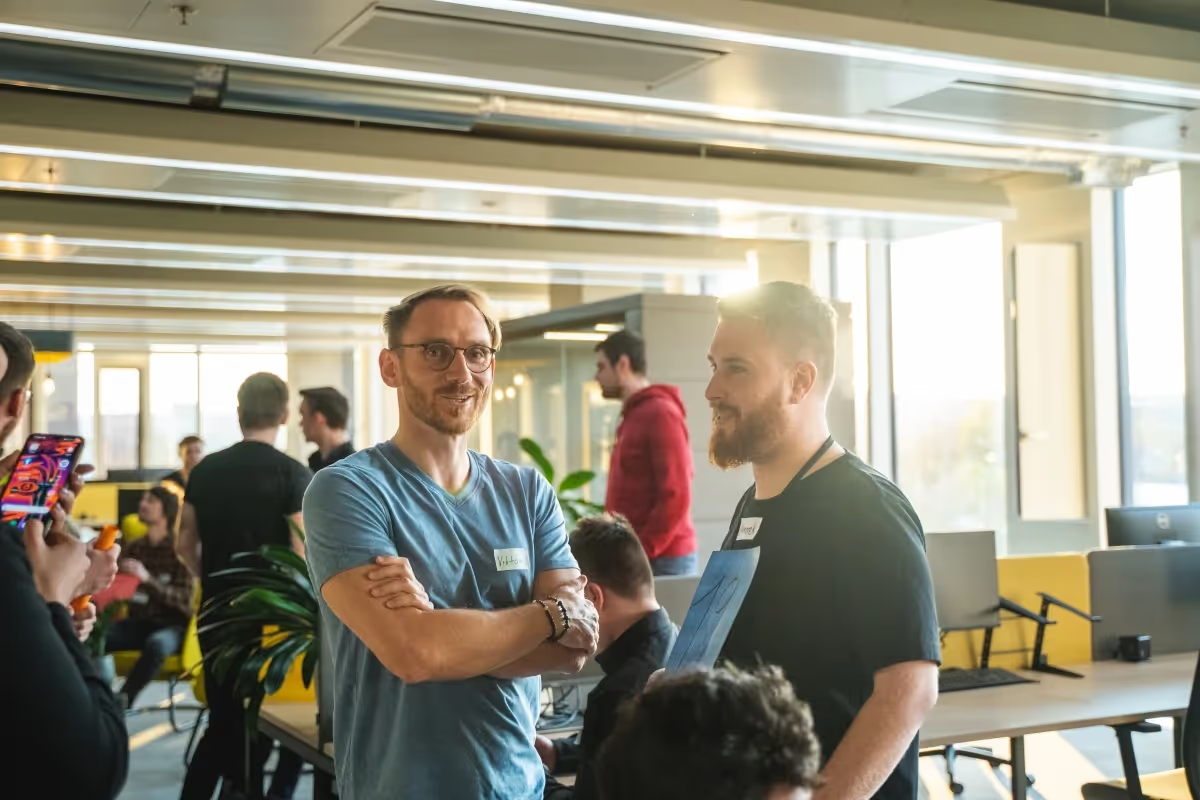
The Ultimate Goal
At the Prague AI Hackathon, we focused on creating a collaborative and engaging environment by prioritizing social impact, participants' education, and networking. We aimed to explore the potential of AI models and how to apply them to real-world problems.
Through teamwork and innovation, participants pushed beyond their limits and developed creative solutions to the challenges presented.
We sought to not only push the limits of AI models but also to create an impact on society. The participants' innovative solutions had the potential to make a real difference in people's lives.
See for yourself!
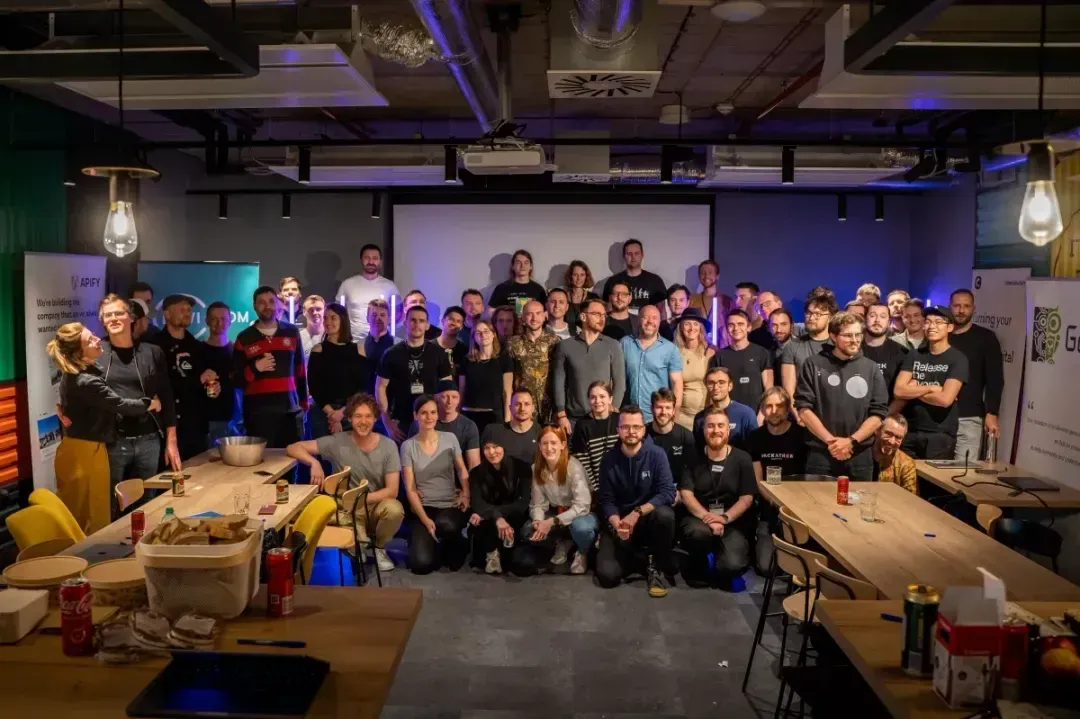
Presenting the Winners: Worwio
The winning solution at the Prague AI Hackathon was a tool that utilized deep learning models to create an audio track for a video in the selected tool. By employing advanced signal processing techniques and leveraging the power of AI, the tool automatically generates high-quality audio in a chosen language that is perfectly synchronized with the original video.
The tool's intelligent algorithms were able to analyze the video's content and generate a suitable translated audio track based on the context, resulting in a seamless and immersive viewing experience for the end users.

Conclusion
We believe the Prague AI Hackathon was a successful event that focused on creating an environment of innovation and creativity by prioritizing social impact, education, and networking. The participants worked tirelessly to develop creative solutions to real-world problems using AI models and showcased the potential of AI models and how to use them to create a positive impact on society.
